What is SEO and How to Optimize WordPress SEO
I believe you are searching for what is SEO and how to optimize WordPress SEO step by step.
After ten years of experience in SEO, I finally started this step-by-step complete SEO guide for you. This guide will not only cover the basics of general SEO, WordPress SEO but also the advanced SEO techniques and methods of natural link building. At the end, even if you are a fresher you will gain a lot that will help you to drive tons of organic traffic towards your website/blog.
So let’s take a start!
The first webpage was launched on August 6, 1991, by Tim Berners-Lee,
And the first webpage address is: http://info.cern.ch/hypertext/WWW/TheProject.html
Do you have any idea of how many websites are there in the world?
These are 1 billion websites all around the world according to the latest statistics by Netcraft and Internet Live Stats and still counting
Another astonishing factor is that there are 350 million blogs and each blog publishes one post each day then the number of blog posts is 300 million posts each day (because many of them don’t regularly update their blog).
But if we talk about the hosted version of WordPress (i.e WordPress.com that is only 20% of the total WordPress usage) then there are 2 million posts published each day.
The majority uses WordPress.Org for which there are no reliable statistics available via any resource.
That means more than 150 people have pressed the published button by the time interval you read the above lines.
That creates a really tough competition to stand out. But you have to if you want your blog in the top Search engines results.
It is great if you have spent 10 hours writing some blog posts but the most important is spending extra effort on optimizing each post with the best SEO essentials.
No wonder thousands of people Google the term “SEO” with every passing second
This is the world of the internet and Google.
Any objection?
Probably not, because there are 3.58 billion internet users and the number is still increasing.
Also, more than 90% of online experience starts with the various search engines through which approximately 92% of search traffic comes to your site by Google.
So, it’s important to pass more than 3/4th part of the camel from the hole, the rest is less than 1/4th pointing the tail. (That means 90% is Google and only 10% are the rest of the Search Engines)
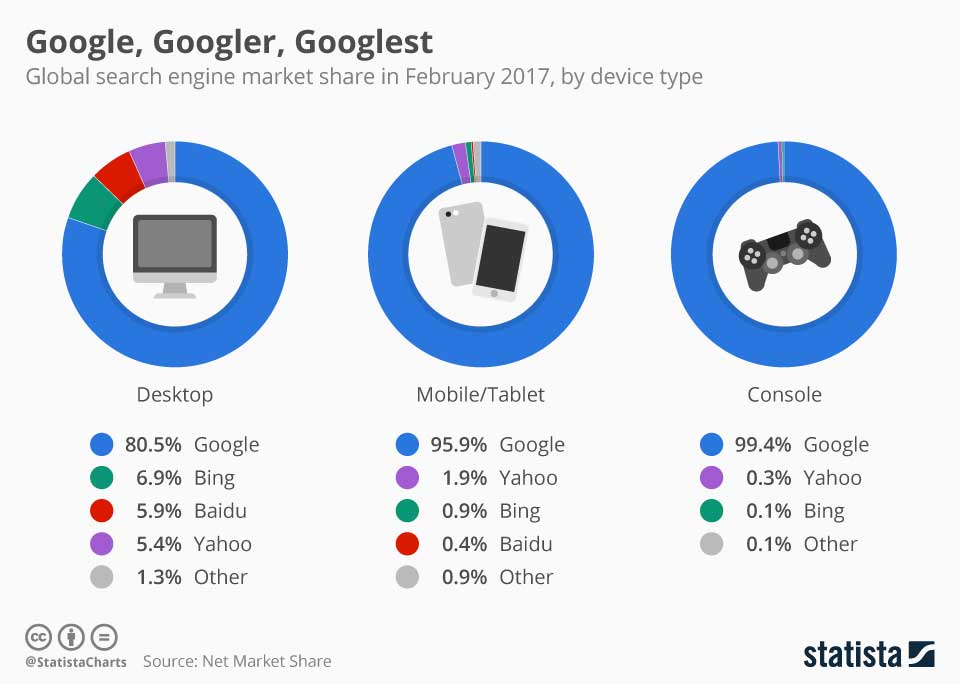
You need to understand and optimize your websites with Google’s SEO factors and guidelines to drive organic traffic towards your websites and the rest of the SEO (for other search engines) followed the most common from Google.
But what does SEO even mean?
Sure, you all know well that it stands for search engine optimization, but what gets optimized?
Is it the design? Code? Or the writing? The links? HTML?
Video Explained by Matt Cutts
What is SEO?
We know that how it becomes complicated when you are completely unaware of the term WordPress SEO
For beginners, I will say don’t be panic, it’s not too complicated as you are thinking. You just need to learn the basics of SEO and start applying on your website/blog. You will gain a lot.
SEO is not a game of tricking the Google algorithm while it’s all about an optimized code and formatting according to the guidelines of Google or other search engines to search your web pages easily.
Google or other search engines show the most SEO-optimized pages on their first page. So it’s all about how you create and publish search engine optimized content to boost traffic towards your website.
“SEO stands for Search Engine Optimization. It is the process of following the guidelines of the search engines (like Google, Bing, Yahoo) for improving the visibility of a specific website or a web page in the organic (earned, natural, unpaid,) SERP (Search Engine Result Page) through qualitative and quantitative traffic. The more visibility of the website in search engines brings the more users to that particular website and that user can also be converted into customers.
More than 94% people come towards a website through search engines top ten results.”
A. Basic SEO Step by Step Complete Guide
Here are the following chapters explaining all about What is SEO and some advanced SEO techniques and methods to self-improve your website.
Part 1: Types Of Search Engine Optimization
Part 2: Unique Content & Search Engines
Part 3: Website Architecture & Search Engines Ranking Factor
Part 4: HTML Code & Search Engines
Part 5: Trust, Authority, Identity & Search Engines Rankings
Part 6: Link Building And Rank Higher In Search Engines
Part 7: Personalization And Search Engine Rankings
Part 8: Social Media And Search Engines Behavior
Part 9: Violations And Search Engine Penalties
B. Advanced SEO Complete Step By Step Guide
How do Search Engines operate?
25 Best SEO Essentials for Every Long-Form Blog Post
How to Get 100/100 on Google PageSpeed Insights
Best Keyword Research Tools for Every Website to Splash in SERPs
10 Best Content Promotion Tools to Accelerate Traffic To Your Blog
Developing account by stopping underperforming AdWords Campaigns
High-Quality Link Building – Search Engines Ranking Factors
How to Improve SEO Ranking with Pillar Pages?
Mobile SEO 2019 – A complete Guide Step by Step
Off-Page SEO Tutorial – Off-Site SEO Quality Link Building Strategies 2019
Social Media – A Search Engine Higher Ranking factor in Google & Bing
Top Ten Search Engine Ranking Factors 2019
What is Google Amp and AMP SEO Benefits in SERPs?
Link Building Sites
How to Do Directories Submission in SEO and High PR (0-9) Directories Submission Sites List 2019 List Working, Tested, Updated?
- High PR 3 Web Directories List 2019 Working And Updated
- High PR 2 Web Directories List 2019 Working Tested And Updated
- PR 1 Web Directories List 2019 Updated
- PR 0 Web Directories List 100% Working
Top 100+ Questions And Answers Website List 2019 Updated 100% Working
300+ Local Business Directory List
List of Top 140+ Web Directories USA
Top High Authority Classified Ads Websites List Updated 2019
Now let’s discuss how you can optimize WordPress SEO from scratch.
How to Optimize WordPress SEO
The Fanman Show has tried its best to provide you the best WordPress SEO guide and actionable SEO steps that can drive tons of organic traffic for your blog.
But let’s start this SEO guide at the beginning.
SEO is the only thing you want to drive organic traffic towards your website/blog.
Most of the WordPress SEO guides are too technical that new users can’t get enough idea about improving their website’s performance with the basic and advance SEO setup.
If you are serious about your every webpage for the first position at Google, then you need to pay attention to the WordPress SEO best practices.
Take a deep breath!
Because we are going to start how you can improve WordPress SEO?
We will share all the top WordPress SEO tips to bring more and more organic traffic to your WordPress site.
This is the ultimate truth that almost more than 70% of bloggers choose WordPress because a majority of the expert opinion says that WordPress is SEO-friendly.
No doubt, WordPress generates SEO-friendly code, but there are a lot of other SEO factors and efforts for maximizing traffic towards your website.
In this basic WordPress SEO guide, we will talk about the following
Table of Contents
- What is SEO
- Why You Need SEO
- Why You Need SEO
- The Basics of WordPress SEO
- Check your site’s visibility settings
- Using SEO friendly URL structure in WordPress
- WWW vs non-WWW in URLs
- The Best WordPress SEO Plugin
- Choosing the Best WordPress SEO plugin
- Add XML sitemaps in WordPress
- Add your site to Google Search Console
- Optimizing your blog posts for SEO
- WordPress SEO Best Practices
- Properly using categories and tags in WordPress
- Make internal linking a habit
- Optimize WordPress comments
- NoFollow external links in WordPress
- Full posts vs summaries (excerpts)
- Speed and Security for WordPress SEO
- Optimize your site’s speed and performance
- Optimizing images in WordPress for SEO
- Security and safety of your WordPress site
- Start using SSL/HTTPS
Why Do You Need SEO?
Why Do You Need SEO?
Search engines are definitely the biggest source of generating organic traffic for all kinds of websites.
We have already discussed that
What you need to know more is, Google and all other Search engines use advanced algorithms to understand your content for indexing in their databases and rank pages appropriately in search results.
These algorithms are intelligent, too catchy but not so perfect. They still need your help to understand what your content is about.
If your website’s content is not well optimized, the search engines (Google, Bing, Yahoo, etc.) will not have an exact idea of what to do with your content. They will index it on inappropriate positions and when the people will search about the topics you write about, your web pages will not appear and you’ll miss out on an opportunity of getting more than 90% of traffic.
So, it’s really important for every type of business owner, bloggers to make their websites search engines friendly to gain maximum traffic volume
Basics of WordPress SEO
No doubt! SEO can be technical in some aspects but it doesn’t have to be, you just need to understand the “basics of WordPress SEO” that can boost up noticeable traffic towards your website/blog.
Don’t worry, if you are not a tech genius to use the following rules and techniques for your WordPress website. These are simple and tricky to drive tons of traffic to your fresh blog post.
Let’s get started optimizing your website.
Check Your Site’s Search Engine Visibility Settings
It is important to mention that working live on WordPress or on WordPress installed on a localhost environment, comes with an option to hide your website from all the search engines.
The proper option is to “discourage search engines from indexing this site”
The basic purpose of these WordPress settings is to optimize and ready your site for search engines before going live to the public.
So you must check this option until you get ready for going live or launching your website.
But what if you checked this option and forget to uncheck it?
Then your website will be unavailable to the search engines until you again uncheck this checkbox.
To do this,
- Login to your WordPress website
- And admin area will open, search Settings then go to Reading
- Scroll down to find the “Search Engine Visibility” and uncheck the checkbox stating “discourage search engines from indexing this site”

- Click on Save Settings
That’s it you’ve done the basic step of your WordPress SEO.
Leave on the search engines’ bot to search and index your website.
The permalinks URLs structure is another important factor in our WordPress SEO guide.
Using the Perfect SEO Friendly URL Structures in WordPress
The humans have more interacted towards words instead of remembering the numbers when we talk about WordPress SEO Friendly URL Structure.
Because the words give a precise idea of what your topic is about
When we spotlight an overall SEO, one of the most important techniques of on-the-page SEO is the perfect and proper URL structure. There are so many options available to create custom permanent links or commonly known as permalinks in WordPress.
It becomes confusing sometimes for WordPress beginners to choose the best permalink structure option from all.
The default settings are not set to SEO Friendly URL Structure in WordPress, rather it consists of a random number from which no one can gather any type of information.
While a perfect permalink structure is one that is easily understandable by humans and embarking the central idea of the webpage.
So, the URL structure of your blog/website, page/post should contain words instead of numbers because words not only clearly explain the content of the page but are easily read by humans and search engines.
Let’s take some examples of non-SEO-friendly URLs
http://www.thefanmanshow.com/?p=1456
https://thefanmanshow.com/archives/35
You have noticed that these URLs have zero user’s readability experience as is the same case with search engines. You can’t get a clear idea of what these URLs are pointing to?
Now let’s look into some SEO friendly URLs:
https://thefanmanshow.com/seo/what-is-seo/
https://thefanmanshow.com/about-thefanmanshow/
Notice that these URLs are readable and a user can guess what they will see on the page just by looking at the URL text.
You can clearly read the above SEO-friendly URLs denoting the topics and increasing the user’s experience.
So, improving your URL structure will contribute to getting a higher ranking in search results.
Here is how you can check and update your WordPress site’s permalink structure.
To set the perfect URL Permalink Structure
- Go to Settings
- Click on Permalinks
- Select the post name option
- Click on the Save button to save the settings
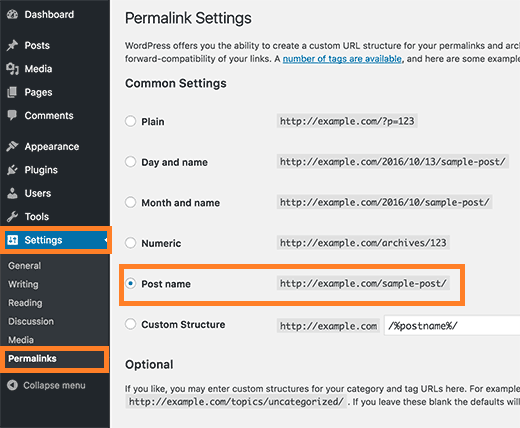
A better SEO URLs structure contains the focus keyword. This focus keyword clearly defines the webpage’s objectivity to the users. Because the focus keyword in the URLs not only helps your webpage/post’s readers about the page but also helps the search engines to crawl and better index your page.
See the graph below by MOZ

This clearly states that you can drive 6.98% more traffic by just using exact match or partial keyword in the domain.
If you are using your website for more than 6 months (with the URLs structure options with Day and Name or Month and Name) then please don’t change your WordPress permalink structure, just continue using that.
Because by changing, you will not only lose your social shares count and current rank but can face multiple penalties by the search engines, because you will have two URLs for every single post, the old and the new one. The search engines will confuse which one to select.
If you are still stubborn about changing your WordPress site URLs structure then hire a professional to set up proper redirects but you’ll still have to lose your social media share counts.
Here are a few tips to create a perfect WordPress Permalink structure
- Always use your focus keyword in every webpage/post URLs
- Keep all the URLs short, precise, and to the point
- Don’t use the date in the URLs structure, because after some time its importance will start decreasing.
WWW VS Non-WWW
If you have just started out your website setup, you will be asked to choose www (http://www.example.com) or non-www (http://example.com) for your website/blog domain URL.
Because the search engines treat both URLs as two different websites. But you need only one and then stick to that.
So to choose between www and non-www URLs,
- Go to dashboard>>settings>>General
- Add your preferred URL (one for both text boxes) to the “WordPress address (URL)” and “Site Address (URL)” text boxes.
As shown in the figure below:
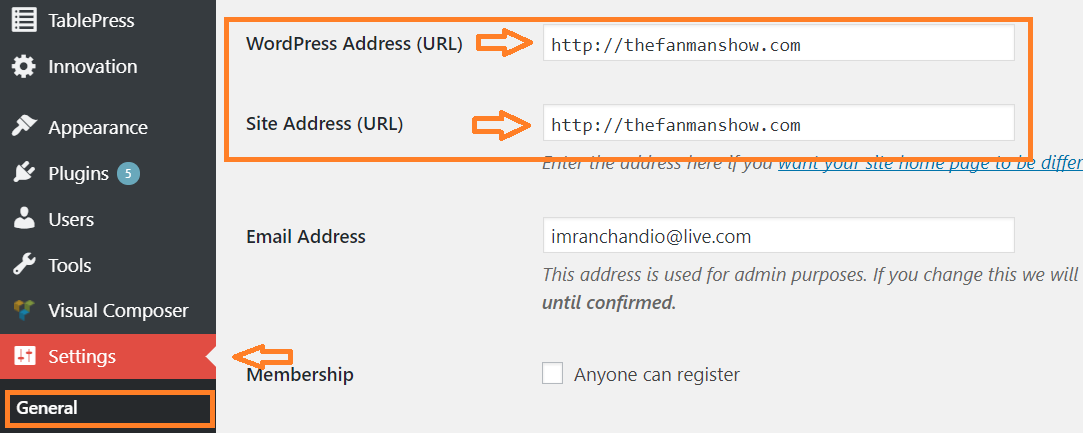
Now, you must be thinking of three possible questions in your mind:
- What is the difference between www and non-www URLs?
- Which one is better for SEO purposes?
- Can I switch my website URL between www and non-www URLs?
Let’s first discuss the difference between www and non-www URLs.
Before we start: for an average user and small business owner, there is absolutely no difference between www vs non-www. It’s completely a personal preference.
For all of you, there is no such difference between www vs non-www URLs. It’s your own preference to select you like the most.
Anyhow, there is only a technical difference between these two which we will cover in this article.
SEO Benefits for Choosing WWW vs non-WWW
You’ll get no SEO benefits either you prefer www over non-www URLs for your preferred domain.
The only thing that matters is to remain consistent with the preferred URL domain at the time of starting a WordPress site or blog.
Can I switch my website URL between www and non-www URLs?
In simple words, DO NOT EVER TRY TO ADD OR REMOVE WWW FROM YOUR WEBSITE URL. Once chosen, stick with that.
Either, you can tell Google about your preferred domain with www or non-www, they will find and index it in their databases.
To specify a preferred domain in Google
- Open Google Webmaster Tools or the Search Console, Home page, click the site you want.
- Click on the gear icon then click on the Site Settings.
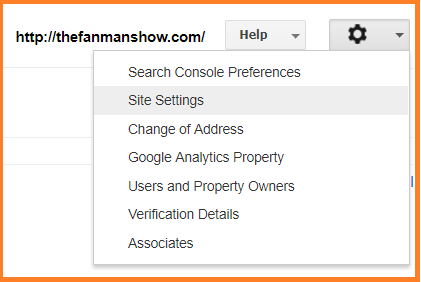
- Select your preferred domain from the domain section option.
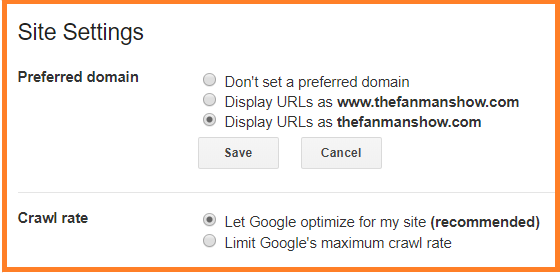
The WordPress SEO by Yoast plugin can be a great resource for you, it will automatically set canonical URL in your site header that will let Google know of your domain preference.
That’s all, you need to do.
Now let’s discuss the technical difference between www vs non-www versions
Technical Difference Between www vs non-www
Carefully, look at the URL for domain name and subdomain. The rest of the parts will be discussed later.
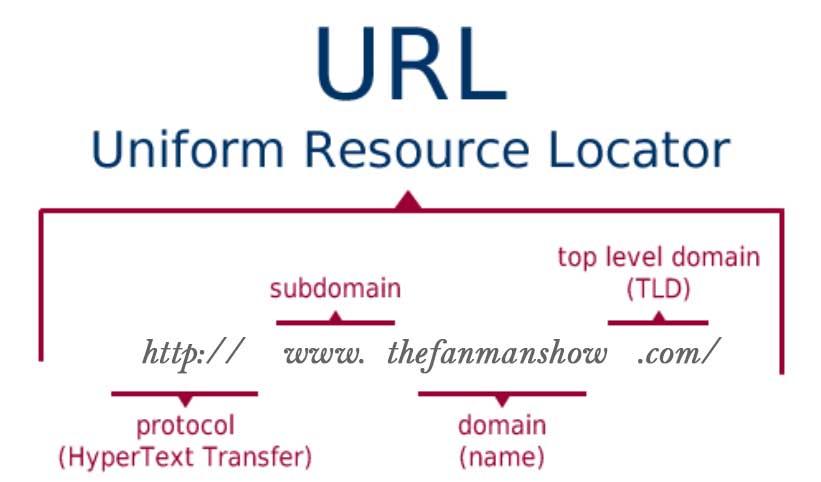
The major technical difference is when adding www. before your website/domain name, it actually acts as a hostname and helps with flexibility with DNS. It also produces an ability to restrict cookies when using multiple subdomains and a lot more.
While non-www domains are also known as naked domains, they do not have any technical advantages.
The bottom line is the search engines treat www and non-www URLs for domains equally and provide equal SEO benefits for both.
Install the Best WordPress SEO Plugin
The best thing about WordPress is that, there is a vast range of free and paid plugins, just you need to select the best option for you to fulfill your needs.
Also, there are thousands of WordPress SEO plugins to choose from.
Instead of installing separate plugins for various SEO purposes, we will help you to find the best WordPress SEO plugin that will fulfill all of your requirements.
Choosing the Best WordPress SEO Plugin
When you need to choose the best WordPress SEO plugin for your blog, only two choices come to mind, Yoast SEO or All in One SEO Pack.
Both SEO plugins are valuable but we are using Yoast SEO WordPress plugin for TheFanmanShow and we are also going to discuss the Yoast SEO plugin complete tutorial for your WordPress site.
Let’s proceed towards the Yoast SEO for WordPress step-by-step guide.
- How to install and setup Yoast SEO plugin in WordPress
- All in One SEO Pack Step by Step Guide
Add XML Sitemaps to Your WordPress Site
Before going to submit/add a sitemap to the various search engines for gaining SEO benefits, you need to clearly understand:
- What is an XML Sitemap?
- What is a sitemap and why it is so important?
- How can you create a sitemap on your WordPress website?
So, here we go about:
What is an XML SITEMAP?
In simple, an XML sitemap is a document that helps Google and other various search engines to better understand and index while crawling it.
A better XML sitemap is a roadmap for all your important pages, posts, and categories of your website/blog. This roadmap provides a lot of SEO benefits, as Google and all other major search engines retrieve important pages of your website very fast.
What is a sitemap and why it is so important?
We will call Sitemaps as inclusion protocols that are created by the webmasters to inform the Google, Bing, Yahoo, and other search engines to find all the URLs of your website for crawling and indexing in their databases.
Once a sitemap is generated, the rest is the responsibility of the search engines to locate all web pages.
The webmasters can add additional information with each URL for Google to better understand for ranking. This additional information to the sitemaps includes:
- When the sitemap was last updated
- How often the website changes
- How important the webpage is in relation to other web pages on the website
This rich-featured information matters a lot for Google to understand completely each webpage and their relation to each other more intelligently.
Understanding Search Engines and Sitemaps
Once you have uploaded the sitemap to your website to your web server, next you need to upload a sitemap URL on Google and other search engines. They will crawl your website with a better understanding of how your website works.
Google: Go to Webmaster Tools account and submit Sitemap URL to Google.
Bing: Sign in with Live account and submit sitemap to Bing in the Webmaster Center section
Yahoo: Sign in to your Yahoo! Account and add the Sitemap URL to the ‘Submit Site feed field’
If you are using WordPress Yoast SEO plugin on your website then it will automatically generate an XML sitemap for your website.
Following is an XML sitemap generated by the Yoast SEO plugin
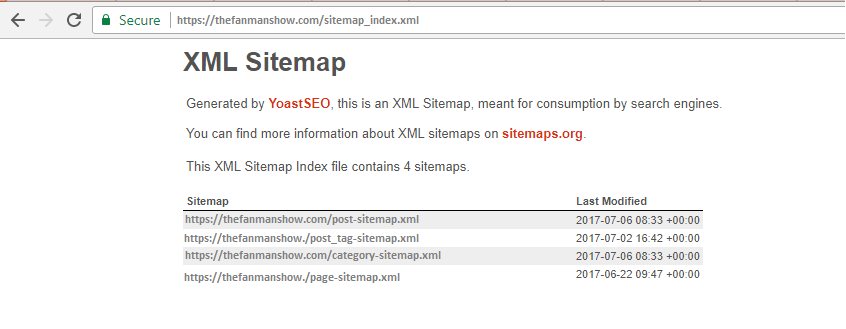
To find your own WordPress XML sitemap for simply follow the syntax:
https://example.com/sitemap_index.xml or http://example.com/sitemap_index.xml
Put your website domain name instead of the example above
The step is to submit an XML sitemap to Google and other search engines to get the WordPress SEO benefits.
Submit Your Site to Google Search Console
Google Search Console is previously known as the Webmaster Tool. This is the set of useful free tools offered by Google to all the webmasters to look into the realities of how Google is indexing their websites.
Google Search Console provides various reports in multiple ways to give you a complete understanding of:
- How your webpages are indexed in search engines?
- How are pages appearing in the Search engine?
- And how many times a page is clicked?
- What type of content strategy is working on your website and what’s not?
- An alert appears when there is something wrong with your website as Google crawlers are accessing your web pages properly or not
- Google Search Console also helps you to find duplicate content on your website
The webmaster analyzes these reports and does every type of important action required to make web pages indexing at a better ranking.
Here, we have a complete tutorial on how to add your WordPress site to Google Search Console.
- Go to Google Search Console
- Sign in with your Google account
- A Google Search Console dashboard will open, click on “Add Property”

- Select Website then enter the complete website address of your WordPress website as shown in the fig below

- Click on the Add button to let your website add in the Google webmaster tool.
Once your website is added, the Google Search Console will fetch all the data and the content of your website and will present you with a complete overview of indexing and suggestions to improve your site.
Now to get the WordPress SEO benefits to submit your sitemap to the Google Search Console.
To do this:
- Click on your website in Google Search Console (a complete overview and suggestion dashboard will open)
- Click on Crawl>> then sitemap
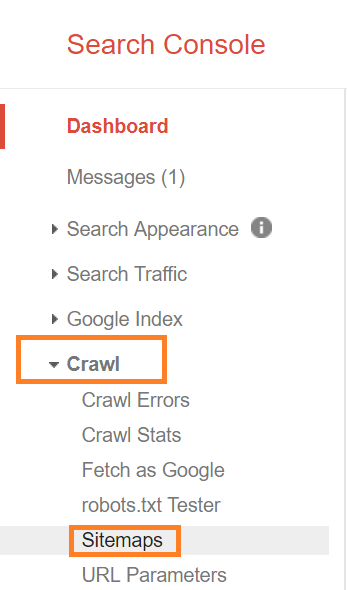
Now your WordPress site XML sitemap complete URL will be “https://example.com/sitemap_index.xml” if generated by the Yoast SEO plugin.
But if you have generated it with Google XML then the address may be “https://example.com/sitemap.xml”
Your domain for example “https://example.com/” will be added already, you just need to enter the address after “example.com/” that is “sitemap.xml” or “sitemap_index.xml”.
Carefully look at how I submitted the sitemap for thefanmanshow.com

- Don’t forget to click on the submit button to submit sitemap to Google Search Console
Once you have successfully submitted your sitemap, it will appear as pending.
Actually, Google takes some time to crawl it, maybe after few hours, you can see more stats about your sitemap with complete information as to how many links, images, and webpages were found and indexed, etc.
We recommend that you check your Search Console at least on a monthly basis for gathering insights and see your website’s SEO progress.
The Fanman Show will recommend you to must do a monthly visit and check sitemap along with other stats on Google Search Console to better optimize your site for WordPress SEO optimization.
